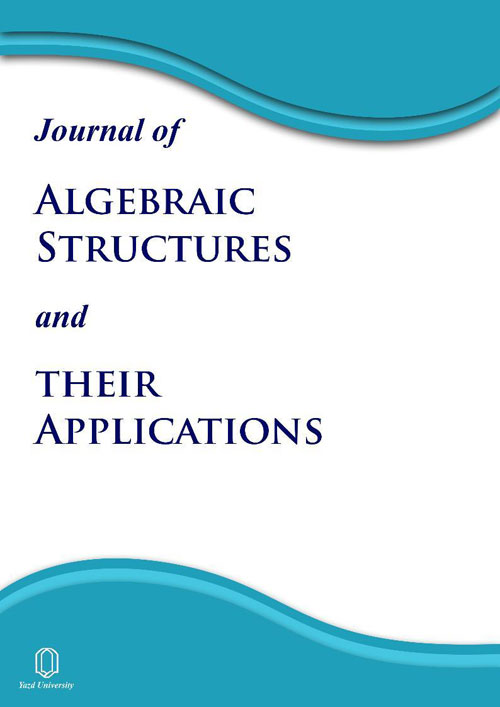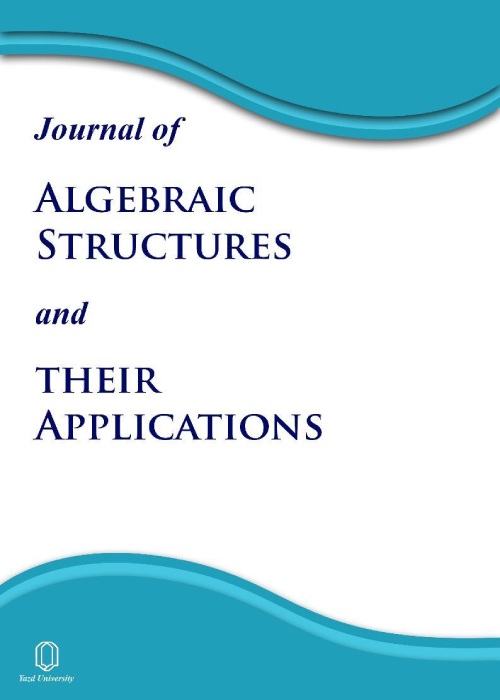فهرست مطالب

Journal of Algebraic Structures and Their Applications
Volume:4 Issue: 2, Summer - Autumn 2017
- تاریخ انتشار: 1396/09/01
- تعداد عناوین: 6
-
-
Pages 1-14ýIn the classical group theory there isý an open questioný: ýIs every torsion free n-Engel group (for n ≥ 4)ý, nilpotent?ý. ýTo answer the questioný, ýTraustasoný [11] showed that with some additional conditions allý ý4-Engel groups are locally nilpotentý. ýHereý, ýwe gave some partialý answer to this question on Engel fuzzy subgroupsý. ýWe show that if μ is a normal 4-Engel fuzzyý subgroup of group Gý, ýx,y in G and a =yxý, ýthen μ| is a generalized nilpotent of class atý most 2ý. ýAlso we define a torsion free fuzzy subgroup and showý ýthat if μ is a 4-Engel torsion free fuzzy subgroup of Gý, ýthen μ| is a generalized nilpotent of class at most 4ý, ýfor conjugate elements a,y in Gý.Keywords: n-Engel group?, ?(torsion free) n-Engle fuzzy subgroup?, ?generalized nilpotent fuzzy subgroup
-
Pages 15-25ýLet Γa be a graph whose each vertex is colored either white or blacký. ýIf u is a black vertex of Γ such that exactly one neighborý ýv of u is whiteý, ýthen u changes the color of v to blacký. ýA zero forcing set for a Γ graph is a subset of vertices Z\subseteq V(Γ) such thatý if initially the vertices in Z are colored black and the remaining vertices are colored whiteý, ýthen Z changes the color of all vertices Γ in to blacký. ýThe zero forcing number of Γ is the minimum of |Z| over all zero forcing sets for Γ and is denoted by Z(Γ)ý. In this paperý, ýwe consider the zero forcing number of some families of Cayley graphsý. ýIn this regardý, ýwe show that Z(Cay(D2n,S))=2|S|-2ý, ýwhere D2n is dihedral group of order 2n and S={aý, ýa3ý, ý... ý, ýa2k-1ý, ýb}. ýAlsoý, ýwe obtain Z(Cay(G,S))ý, ýwhere G= is a cyclic group of even order n and S={ai :ý 1≤ i≤ ný and i is odd}ý, ýS={aiý :ý1≤ i≤ ný and i is odd}\{ak,a-k} or |S|=3ý.
-
Pages 27-38The non-commuting graph Γ(G) of a non-abelian group G with the center Z(G) is a graph with the vertex set V(Γ(G))=G∖Z(G) and two distinct vertices x and y are adjacent in Γ(G) if and only if xy≠yx . The aim of this paper is to compute the spectra of some well-known NC-graphs.Keywords: non-commuting graph, characteristic polynomial, center of group
-
Pages 39-43Let R be a commutative Noetherian ring and let M be a nitely generated R-module. If I is an ideal of R generated by M-regular sequence, then we study the vanishing of the rst Tor functors. Moreover, for Artinian modules and coregular sequences we examine the vanishing of the rst Ext functors.Keywords: regular sequence, coregular sequence
-
Pages 45-55ýIn a (t,n)-threshold secret sharing schemeý, ýa secret s is distributed among n participants such that any group of t or more participants can reconstruct the secret togetherý, ýbut no group of fewer than t participants can doý. In this paper, we propose a verifiable (t,n)-threshold multi-secret sharing scheme based on Shao and Caoý, ýand the intractability of the elliptic curve discrete logarithm problem (ECDLP) by using generalized Jacobian of elliptic curvesý. ýThe proposed scheme has all the benefits of Shao and Caoý, ýhoweverý, ýour scheme no need to a secure channelý. ýFurthermoreý, ýwe exploit the techniques via elliptic curves to perform the schemeý. ýThis can be very importantý ýbecause the hardness of discrete logarithm problem on elliptic curves increases security of the proposed schemeý.Keywords: ?Secret Sharing?, ?Elliptic Curves?, ?Generalized Jacobians
-
Pages 57-69ýLet F ~ =(Q,§,R ~ ,Z,ω,δ ~ ,ýF 1 ,F 2 ) ý ýbe a general fuzzy automaton and the set of its states be a group.ý ýThe aim of this paper is the study of applications of a group in aý ýgeneral fuzzy automatoný. ýFor this purposeý, ýwe define the conceptsý ýof fuzzy normal kernel of a general fuzzy automatoný, ýfuzzy kernelý ýof a general fuzzy automatoný, ýadjustableý, ýmultiplicativeý. ýThen weý ýobtain the relationships between them.ýKeywords: Fuzzy automata, group, normal subgroup, fuzzy subgroup, fuzzy normal subgroup


